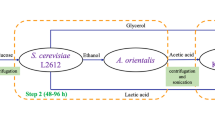Abstract
Low-cost raw materials can be used to reduce significantly the production cost of polyhydroxyalkanoates (PHA). In this study, extruded rice bran (ERB) and extruded cornstarch (ECS) were used as carbon sources to produce PHA by an archaea, Haloferax mediterranei, which cannot use native rice bran or cornstarch as a carbon source. By employing pH-stat control strategy to maintain pH at 6.9–7.1 in a 5-liter jar fermentor using ERB:ECS (1:8 g/g) as the major carbon source, we obtained a cell concentration of 140 g/L, PHA concentration of 77.8 g/L and PHA content of 55.6 wt.% in a repeated fed-batch fermentation. In contrast, when ECS was used as the major carbon source, we obtained 62.6 g/L cell concentration, 24.2 g/L PHA concentration and 38.7 wt.% PHA content. Under a hyper-saline condition and with no nitrogen-limitation restriction, the repeated fed-batch process can be sustained a long time for the mass production of PHA.

Similar content being viewed by others
References
Akiyama M, Tsuge T, Doi Y (2003) Environmental life cycle comparison of polyhydroxyalkanoates production from renewable carbon resources by bacterial fermentation. Polym Degrad Stab 80:183–194
Anderson AJ, Wynn JP (2001) Microbial polyhydroxyalkanoates, polysaccharides and lipids. In: Ratledge C, Kristiansen B (eds) Basic biotechnology. Cambridge University Press, New York, pp 325–333
Anton J, Meseguer I, Rodriguez-Valera F (1988) Production of an extracellular polysaccharide by Haloferax mediterranei. Appl Environ Microbiol 54:2381–2386
Bae HD, Yanke LJ, Cheng KJ, Selinger LB (1999) A novel staining method for detecting phytase activity. J Microbiol Meth 39:17–22
Chen LJ, Wang M (2002) Production and evaluation of biodegradable composites based on PHB-PHV copolymer. Biomaterials 23:2631–2639
Chen CW, Lei BC, Yeh KW, Duan KJ (2003) Recombinant sweet potato sporamin production via glucose/pH control in fed-batch culture of Saccharomyces cerevisiae. Process Biochem 38(8):1223–1229
Choi JI, Lee SY (1997) Process analysis and economic evaluation for poly(3-hydroxybutyrate) production by fermentation. Bioprocess Eng 17:335–342
Choi J, Lee SY (1999) Factors affecting the economics of polyhydroxyalkanoate production by bacterial fermentation. Appl Microbiol Biotechnol 51:13–21
Choi HJ, Kim J, Jhon MS (1999) Viscoelastic characterization of biodegradable poly(3-hydroxybutyrate-co-3-hydroxyvalerate). Polymer 40:4135–4138
D’Souza SE, Altekar W, D’Souza SF (1997) Adaptive response of Haloferax mediterranei to low concentration of NaCl (<20%) in the growth medium. Arch Microbiol 168:68–71
Fernandez-Castillo R, Rodriguez-Valera F, Gonzalez-Ramos J, Ruiz-Berraquero F (1986) Accumulation of poly(β-hydroxybutyrate) by halobacteria. Appl Environ Microbiol 51(1):214–216
Lillo JG, Rodriguez-Valera F (1990) Effects of culture conditions on poly (β-hydroxybutyric acid) production by Haloferax mediterranei. Appl Environ Microbiol 56(8):2517–2521
Pachence JM, Kohn J (2000) Biodegradable polymers. In: Lanza RP, Langer R, Vacanti J (eds) Principles of tissue engineering. Academic, New York, p 266
Rodriguez-Valera F, Lillo JG (1992) Halobacteria as producers of polyhydroxyalkanoates. FEMS Microbiol Rev 103:181–186
Savenkova L, Gercberga Z, Kizhlo Z, Stegantseva E (1999) Effect of phosphate supply and aeration on poly-β-hydroxybutyrate production in Azotobacter chroococcum. Process Biochem 34:109–114
Steinbuchel A, Fuchtenbusch B (1998) Bacterial and other biological systems for polyester production. Trends Biotechnol 16:419–427
Sudesh K, Abe H, Doi Y (2000) Synthesis, structure and properties of polyhydroxyalkanoates: biological polyesters. Prog Polym Sci 25:1503–1555
Acknowledgements
The authors would like to thank National Science Council of the Republic of China for financially supporting this work under grant number NSC92-2621-Z-036-001. Partial financial support from TATUNG Co. is also appreciated.
Author information
Authors and Affiliations
Corresponding author
Rights and permissions
About this article
Cite this article
Huang, TY., Duan, KJ., Huang, SY. et al. Production of polyhydroxyalkanoates from inexpensive extruded rice bran and starch by Haloferax mediterranei . J IND MICROBIOL BIOTECHNOL 33, 701–706 (2006). https://doi.org/10.1007/s10295-006-0098-z
Received:
Accepted:
Published:
Issue Date:
DOI: https://doi.org/10.1007/s10295-006-0098-z




